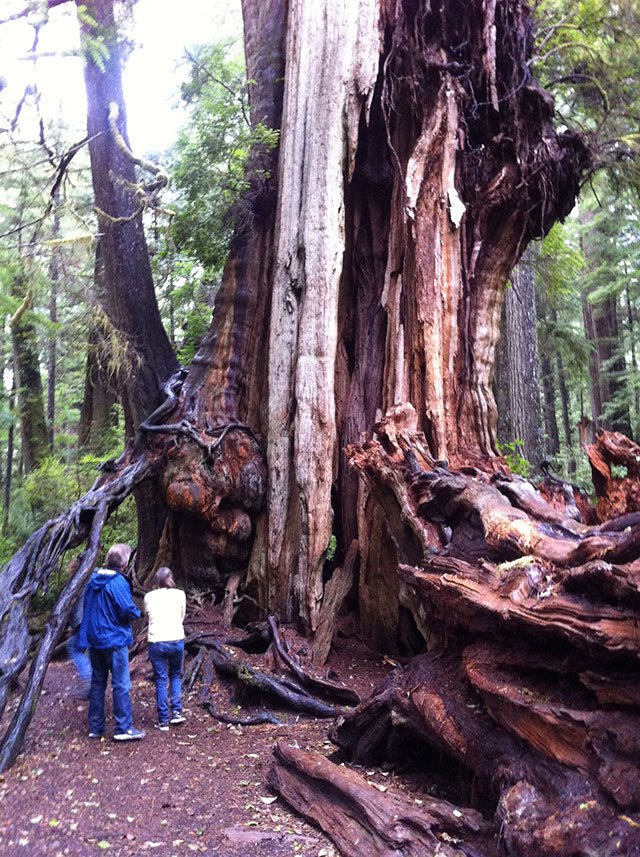The demise of the record-breaking, Quinault Big Cedar tree the weekend of July 8 had the same impact to locals and tourists comparative to the collapse of the Seattle Space needle. Except the 1,000 years of history, the tree represented is far beyond the short life of the needle. Following the loss of the Kalaloch cedar tree during a heavy wind March 3, 2014, the two, record-setting cedar trees bring an end to representing time extending back to the end of the Ice Age and through generations of heritage for coastal Olympic Peninsula folks.
The latter is documented by a 1935 photo of Cleve Jackson, former Quinault Indian chairman pointing out an old growth red cedar within the reservation boundaries that bears evidence of an aboriginal, Stone Age cut. While buildings, cities and other monuments mark urban heritage, coastal heritage is marked by awe inspiring giant trees that once covered the land.
The recently lost tree was the largest tree in the world outside of the California redwoods and sequoias, Its 174-foot height drew visitor from around the world to the trail two miles up Lake Quinault’s North Shore Road. The trail is now closed. The record tree, nominated in 1941 by F.W. Mathias of Hoquiam, was 62 feet, eight inches in circumference with a canopy spread of 45 feet. It contained an amazing volume of wood calculated at 15,300 cubic feet. The root damage caused by the trampling of visitors around its base is thought to be the cause of its demise. Now a 20-foot stump indicates its grave.
An earlier loss of a record-sized tree near Kalaloch makes the collapse of the venerable tree even more heart felt. The Kalaloch western red cedar (Thuja pilcata) split in half following a severe, heavy wind combined with five days of saturating rain that twisted the 19.8 foot diameter. The 175-foot tall tree that was also 1,000 years old. The Kalaloch site is one of the most visited areas on the Olympic National Park, according to park officials. Although the tree, just as most stumps, remains alive, it will now experience a very slow death. The access road to the tree, five miles north of Kalaloch Lodge is closed due to safety hazards posed by the tree.
While Grays Harbor still has some mighty big trees, approximately 10 mixed specie trees, in the Olympic National Park’s “Forest of Giants,” it leaves Jefferson County, bordering on the north of the Harbor, as the location of the biggest tree. But it has close ties to the Harbor folks as it was discovered by Wiley and Ed Duncan, Rayonier Co. loggers when they were cutting the state timber sale in 1975. The tree, 19.4 feet in diameter and 178 feet tall is also 1,000 years old. Located on Department of Natural Resource state school trust lands, the Fork’s Lion Club lobbied the Commissioner to remove the tree from the timber sale. Their successful efforts caused the tree to be renamed, “The Duncan Cedar” in honor of the two loggers.
The tree plantation seeded to hemlock in 1975 and planted in Douglas fir the following year also has experienced natural reseeding with some the offspring of the Duncan Cedar.
The tree is located near the Nolan Creek bridge about 20 miles south of Forks on road N1000 between mileposts 170 and 171 with signage to the tree 4.1 miles east of State Route 101.
Record trees are based on calculating the trees total point count by using the total circumference inches plus total feet of height plus one-quarter of the average crown spread in feet to equal the total points. The American Forest Association maintains a list of about 750 outstanding trees is updated semi-annually.
The Matheny Creek western hemlock, on the south side of Queets River Road 2.8 miles from the creek, ties the record for the world’s largest tree with a 291 inch circumference, 227 foot height and a 49 foot spread of canopy.
A champion Douglas fir off of US101 north of Ruby Beach is through a maze of logging roads and is not easily found. The majority of the Olympic Park record trees are located on hiking trails with maps available at USFS or Park ranger stations; except for the 191- foot Sitka Spruce on Lake Quinault’s South Shore Road that is located on the private land of the Rain Forest Resort Village. A trail to the tree is well-signed and is a never ending marvel of observing the closest living thing to being around forever.
Looking back at old newspapers of the region one finds a treasury of big trees for those enamored by the history of our natural world, the eons of logging history and settlement that has brought us the managed commercial forests of today.
In 1900 a few of the big fellows included the Montesano witness tree for the government corner in township 16-7 measured 19-feet and 4-iches as high up as surveyors could hold the chain and measured 21-22 feet at ground level. Three cedars at John’s River measured between 20-21 feet in diameter. G.M. Wade’s claim on Black Creek just north of Montesano was an even bigger monster as measured in 1880. It sported a circumference of 66-feet, six inches above the root spread. No one ever knew how tall it had been because it was broken off at 100-feet in height. It was destroyed by fire in 1881.
More information about the area’s record sized trees is found on www.americanforests.org/bigtrees/bigtreesFOQS.


